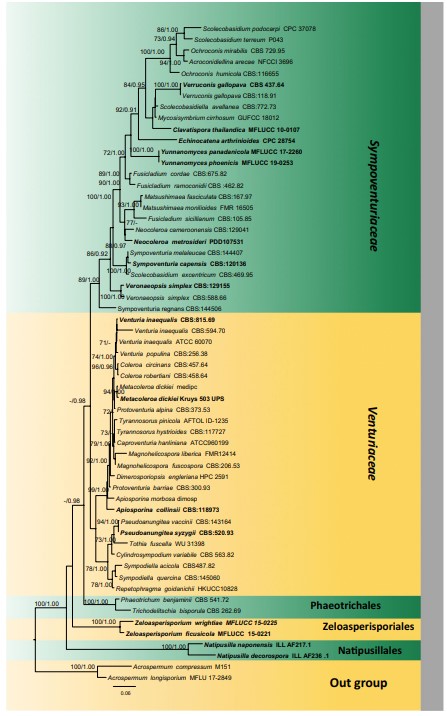Venturiaceae E. Müll. & Arx ex M.E. Barr, Mycologia 71(5):947 (1979).
MycoBank number: MB 81516; Index Fungorum number: IF 81516; Facesoffungi numbers: FoF 06352, 217 species.
Saprobic or parasitic on leaves or stems usually on dicotyledons, sometimes on monocotyledons. Sexual morph: Ascomata superficial or immersed or slightly erumpent at maturity, scattered or gregarious, single locules in a stroma or below a blackened clypeus, globose to subglobose, membraneous or carbonaceous, usually with seta or without seta, ostiolate, sometimes occurring on a well-developed subiculum with ascomata. Peridium comprising a pigmented single cell layer of textura angularis. Hamathecium comprising branched, cellular pseudoparaphyses. Asci 8-spored, bituni- cate, fissitunicate, evanescent, broadly or usually obclavate or cylindrical, with or without short pedicel, ocular chamber distinct. Ascospores uni-seriate or overlapping 2-seriate, cylindrical to ellipsoidal, with broadly rounded apex, hyaline or light greenish, or pale yellow to brown, 1-septate upper cell shorter and broader than lower one. Asexual morph: Hyphomycetous. Conidiophores pigmented, singly or in clusters, simple or branched. Conidiogenous cells integrated, terminal or sometimes intercalary, proliferating sympodially or percurrently, with conspicuous annellations Conidia solitary or arranged as chains, pigmented, aseptate or septate.
Type: Venturia Sacc.
Notes: Venturiaceae comprises 12 genera (Wijayawardene et al. 2018). The members of this family are characterized by having sphaerical superficial or erumpent ascomata comprising elongated or oblong or nearly cylindrical, bitunicate, 8-spored asci and 2-celled, symmetric or asymmetric ascospores, which are hyaline or pale green when immature and olive-brown or greyish green, or rarely dark brown at maturity (Li et al. 2014). Crous et al. (2018b) included Cylindrosympodium, Pseudoanungitea, Sympodiella, Tothia, and Repetophragma in Venturiaceae based on their phylogenetic analyses without including all genera of the family in their analyses. In our analyses (Fig. 90), we included all genera that have sequence data and found that the main clade of Venturiaceae comprises species of Apiosporina, Caproventuria, Coleroa, Dimerosporiopsis, Metacoleroa, Protoventuria, Tyrannosorus, and Venturia with high support (99% ML, 1.0 BYPP). Cylindrosympodium, Pseudoanungitea, Sympodiella, Tothia, and Repetophragma cluster together as a sister clade with the main clade of Venturiaceae with low support, but sometimes in other analyses, these genera did not cluster with members of the family (data not shown). We presume that this separate clade can be a new family in Venturiales, and tentatively accept Cylindrosympodium, Pseudoanungitea, and Sympodiella in Venturiaceae as their type species cluster within this clade. More sequence data are needed to confirm this clade as a new family. The placement of Repetophragma is not clear as the sequence data of type species is unavailable, thus we follow Wijayawardene et al. (2020) and place it in Pleosporales genera incertae sedis. We exclude Tothia from Venturiaceae base on its morphology (thyriothecial ascomata), and place the genus in Microthyriales genera incertae sedis.

Fig. 90 Phylogram generated from maximum likelihood analysis (RAxML) of genera in Venturiales based on LSU, SSU and RPB2 sequence data. Maximum likelihood bootstrap values equal or above 70%, Bayesian posterior probabilities equal or above 0.90 (MLBS/ PP) are given at the nodes. An original isolate number is noted after the species name. The tree is rooted to Acrospermum compressum (M151) and Acrospermum longisporium (MFLU 17-2849). The extype strains are indicated in bold. Hyphen (-) represents support values below 70% MLBS and 0.90 PP
Genera
